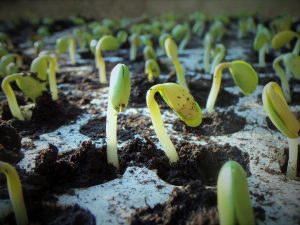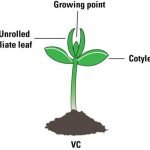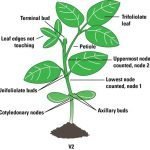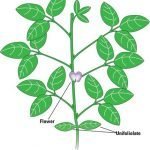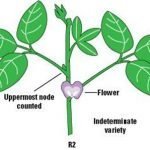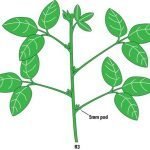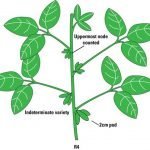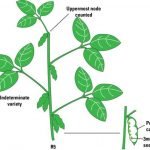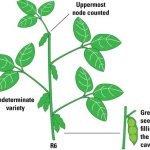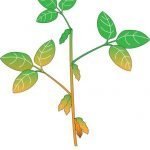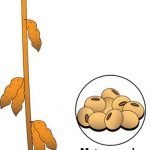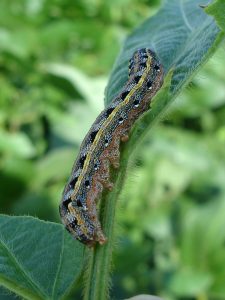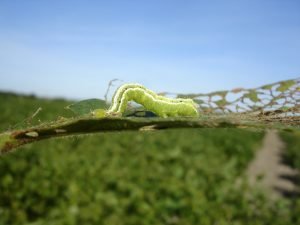What is Soybean?
The soybean is a bushy, free branching annual that grows 12-36 inches tall belonging to family Fabaceae. Soybeans are native to East Asia.
The whole plant i.e. stems, leaves, and pods are hairy. Pods extend from 1-4 inches long in clusters of three to five. Each pod contains 2-5 seeds. Flowers are small white or purple. Soybean seed color ranges from black to grey, brown, green, yellow, white, and striped. The roots of soybean live in symbiosis with a bacteria, that delivers the nitrogen to the plant and in turn, plants provide shelter to it.
Vegetative Stages of a Soybean plant
Reproductive Stages of a Soybean Plant
Selection of planting site for Soybean
Soybean is a warm temperature loving legume crop. It can also tolerate partial shade but the yield will be low. Waterlogging soil should be avoided for soybean plants. Loose, well-drained soil rich in organic matter with pH 6.0-6.8 is best for its proper growth and best yield.
Climate and Soil
Although soybeans are adapted to grow in a wide range of soils and climates, it requires adequate soil moisture for germination and seedling establishment.
Light, loose, well-draining loamy soil with a pH of 6.5 is the best soybean proper growth.
Soybean is a short-day plant, requiring hot weather for optimum production. It can be grown year-round in most parts of the tropics. Plants can be grown at ambient temperatures between 15 and 27°C (60–80°F) although temperature below 21°C (69.8°F) and above 32°C (89.6°F) may reduce flowering. Temperatures exceeding 40°C (104°F) are detrimental to seed production. Plants are sensitive to waterlogging but are tolerant of drought conditions once established.
Why inoculation is important for Soybeans?
Soybeans fulfill their large nitrogen requirement from the air via Rhizobium bacteria forming nodules on their root system. Soybean seed should be inoculated with group rhizobia to get effective nodulation and ensure adequate nitrogen nutrition to the plant. Rhizobium bacteria require low nitrogen soils for optimum growth.
How to grow Soybean plants?
Germination
When soybean seed is planted in the soil, it absorbs moisture changing from less than 13% to about 50% in several years. The first root called radical emerges and begins to grow downward for establishing the root system after 2-3 days of sowing. After 15 days, first true leaves (cotyledons) appear which provide food to the seedlings. Cotyledons drop off when the additional leaves develop. Seed germination and emergence is the critical period in soybean. So, extensive care should be given at this stage.
The soil temperature should be above 13oC for successful germination but above 25oC is optimum for rapid emergence.
Propagation
- Soybean is propagated directly from seed.
- If seeds are to be planted in a field where soybean has not been grown in the 3–5 year previous, they should first be inoculated with nitrogen-fixing bacteria.
- Before planting any crop, not only soybean the seedbed should be prepared by removing any crop residue, weeds, and large stones.
- Then tillage operation should be carried out to break the large clods of Earth, solarization, and improve aeration of the soil.
- Propagation of soybean is done mainly through seeds and can be sown mechanically or by hand.
- Seeds are usually planted at a depth 3.2–4.5 cm (1.25 to 1.75 in) in rows spaced 30 cm (11.8 in) apart in case of tilled soil.
- For no-till planting sow seeds in the stubble of a previous crop without first cultivating the soil. In this method, seeds are drilled into the soil in rows spaced 17.8 cm (7 in) apart.
- No-tillage practices reduce soil erosion and conserve soil moisture.
Plantation time
Sow soybean in spring 2 to 3 weeks when the soil temperature rises to 60 F. 60F to 70F is favorable for soybean. Soybeans are extremely sensitive to frost.
Sowing depth
Sowing depth is important for the good establishment of the crop. Shallow sowing will lead to desiccation of the seed and too deep can cause the failure of seedling emergence. 5 cm depth is usually optimum for sowing.
What will happen if you don’t sow soybean in time?
The plant will be unable to reach optimum vegetative growth, low pods, and lengthens the maturity time if sown late. If you plant in April/May, there will be an increased risk of weather damage, small immature seed, and reduced time available for winter crop planting.
Poor vigor seed, sowing depth, high/low seedbed moisture, and crusting can create problems to crop establishment. High plant density can also increase the severity of Sclerotinia root rot.
Is it possible to grow soybean in a container?
Yes, Soybean can be grown in 8 inches deep container. But it will be a poor choice because it is a bushy large space-occupying crop.
How to Care for Soybean plants?
Use well-decayed compost manure prior to planting and side-dress soybean with that manure at midseason. As soybean can fix nitrogen through the air with the help of nitrogen-fixing bacteria, it is not necessary to add more nitrogen-rich fertilizers to planting beds.
Keep planting beds free from weeds, stubbles, soil debris. Conserve soil moisture through mulching when the soil temperature rises more than 60oF. Soybeans should not be handled when they are wet or covered with heavy dew as this may cause to spread fungal spores.
How much fertilizer to apply?
- Soybeans require a large number of soil nutrients.
- A well-nodulated crop up to 100 kg N/ha will be produced for every ton of grain produced.
- Soybeans require a huge quantity of phosphorous. Soybean will take up 11 kg P/ha for every ton of grain produced and the grain will remove 7 kg P/ha. Soybeans have an extended period of phosphorus uptake right up until mid-pod-fill.
- The sulfur requirement can be fulfilled through single superphosphate.
- There may be a deficiency of Molybdenum in low pH soil but the addition of lime and Calcium chloride can correct the pH above 4.8.
Weed management
Weed infestation is quiet less in soybean. Soybean can compete for weed as it is bushy, vigorous, and can achieve full canopy coverage of the ground early. Narrow sowing rows and early sowing can help soybean to tackle weed problem. Early weed control is necessary for highest yields because bean seedlings are at their most vulnerable between 4-7 weeks from sowing.
The use of pre-emergent herbicides against hogweed and other grasses is recommended initially followed up by post-emergent herbicide at an early growth stage if required. Broadleaf weeds such as Bathurst Burr and BlackBerry Nightshade and grass weeds such as Barnyard Grass are competitors of soybean.
Water and Feeding
Watering should be done regularly during flowering and pod formation. Overhead watering should be avoided as it can cause flowers and pods to fall off. You can conserve soil moisture through mulching when the soil temperature rises more than 60oF.
When a plant attains height more than 20 cm high then it will demand more water. So, irrigation every 10-14 days will be required.
Watering intensity is usually reduced at the end of the crop’s growth. Many growers avoid late irrigation to make the harvest easier. However, water stress at the final stages of pod fill can be very costly to yield. This is why it is better to keep moisture availability up until 50% of pods have reached physiological maturity (yellowing pods and leaf drop).
Tensiometers can be used for monitoring soil moisture especially in the later stages of growth. Soybeans are a relatively low water use crop. Depending on the season and soil type, irrigation water use varies between 4.5-8.5 ML/ha, and the average is around 6.5 ML/ha.
Companion crops
Strawberries, corn, cucumbers, celery, summer savory. Never plant soybeans with garlic or onion.
Soybean Plant diseases and Cure
1. Bacterial blight
Causal organism: Pseudomonas syringae
Management
- Use only certified seed
- Use plant resistant varieties
- Treatment of seeds with an appropriate antibiotic prior to planting.
- spray copper-based fungicide before the appearance of symptoms.
2. Bacterial pustule
Causal organism: Xanthomonas campestris
Management
Use varieties resistant to bacterial pustule spray plants with an appropriate protective copper-based fungicide before the appearance of symptoms.
3. Rhizoctonia stem rot
Causal organism-Rhizoctonia solani
Cause
Warm temperature and high humidity favor rust development.
Management
- Use resistant varieties
- Appropriate applications of foliar fungicides
4. Sclerotinia stem rot
Causal organism- Sclerotinia sclerotiorum
Cause
- Cool and wet weather
- spacing between plants
- The resistance of pathogen to many fungicides
Management
- Avoid soybeans planting in fields where common bean, sunflowers are grown in the previous season.
- Do not irrigate excessively if plants are no longer flowering.
- Plant soybean varieties that are less susceptible to the disease.
5. Downy mildew
Causal organism: Peronospora manshurica
Cause
Warm temperatures and high humidity
Management
- Seed treatment with an appropriate fungicide prior to planting.
- Grow fungal resistant varieties.
- Follow crop rotation.
6. Frogeye leaf spot
Causal organism-Cercospora sojina
Cause
Warm and humid conditions
Management
- Plant high-quality seed and resistant varieties;
- Rotate crop away from soybean for a period of 2 years
- Seed treatment with an appropriate fungicide prior to planting
- Use appropriate foliar fungicide.
Soybean Pests and Management
1. Armyworms (Beet armyworm, Western striped armyworm)
Causal organism-Spodoptera exigua, Spodoptera praefica
Management
- Use natural enemies which parasitize the larvae
- Application of Bacillus thuringiensis
2. Cucumber beetles (Western striped cucumber beetle, Western spotted cucumber beetle)
Causal organism: Acalymma vittata, Diabrotica undecimpunctata
Cause
When temperatures begin to reach and exceed 12.7°C (55°F)
Management
- Allow bees to pollinate plants.
- kaolin clay can effectively control small beetle populations.
3. Mexican bean beetle
Causal organism: Epilachna varivestis
Comments
Mexican beetles overwinter as adults and undergo 2-3 generations per year
Management
- Use early varieties as it may escape damage from beetles.
- Remove overwintering sites such as brush and leaves on the ground.
- Handpick larvae and adults.
- Destroy leaves containing eggs.
- If infestation is heavy, apply insecticidal soap to undersides of the leaves.
Harvesting
For shelling and fresh use: 45 – 65 DAS (Days after sowing)
For dry soybeans: 100 or more days
All soybean pods reach maturity at the same time. For harvesting, pull the whole plant and hang it upside down to dry. Harvest the whole plant when the leaves and stems have turned yellow and the seed pods brown to black. Soybeans for fresh use are cut while still green. Seeds are removed from the pods by threshing after harvesting.
Storing
Soybeans should be harvested at 15% moisture content to reduce seed damage but the seed should be stored at below 13% to prevent from fungus and kept cool to maintain viability.
Uses of Soybean
- Consumed as a protein diet(40%)
- The byproduct of oil extraction can be used as an animal feed.
- Seeds can be used to make dairy substitutes (milk, margarine, and yogurt) and meat substitutes (veggie burgers).
- Both seeds and pods can be used for oil extraction which is used to make products such as paint, linoleum, and soap.
- The byproduct of oil extraction is used as an animal feed.
- Grown as a cover crop and used as animal fodder or hay.
Remember
Soybeans should not be eaten raw because it contains trypsin inhibitor which prevents the digestion of proteins.
The side effect of excessive use
- Intestinal side effects such as constipation, bloating, and nausea.
- Allergic reactions involving a rash, itching, and anaphylaxis in some people.
- Mild stomach pain and tiredness.

Amelia is a plant and nature lover! Ever since she was little, she loved spending time in her family’s garden and learning about how to care for each plant individually. As an adult, she has dedicated herself to sharing what she has learned and continuing to expand her knowledge on the plant kingdom.

